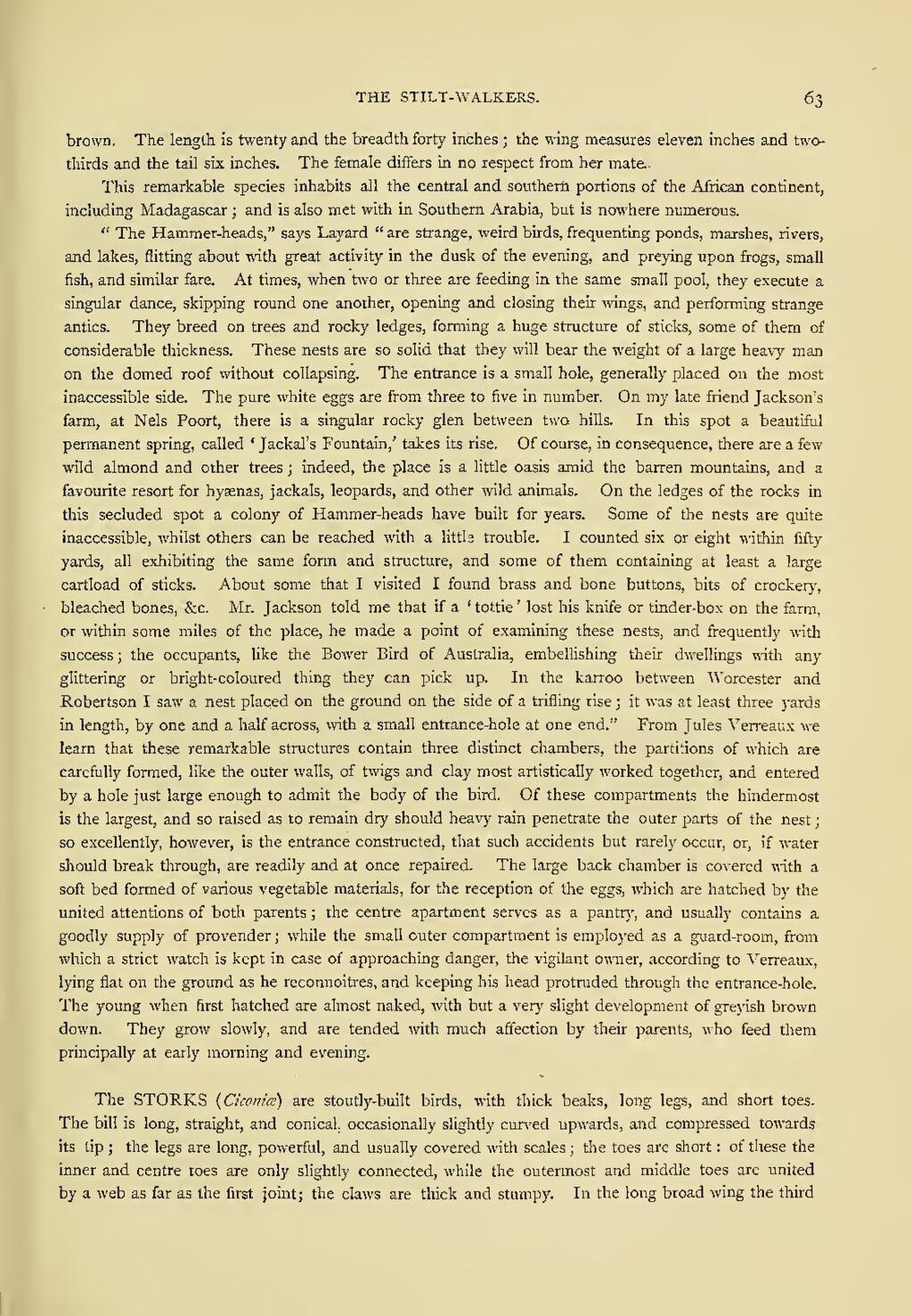brown. The length is twenty and the breadth forty inches; the wing measures eleven inches and two-thirds and the tail six inches. The female differs in no respect from her mate.
This remarkable species inhabits all the central and southern portions of the African continent, including Madagascar; and is also met with in Southern Arabia, but is nowhere numerous.
"The Hammer-heads," says Layard "are strange, weird birds, frequenting ponds, marshes, rivers, and lakes, flitting about with great activity in the dusk of the evening, and preying upon frogs, small fish, and similar fare. At times, when two or three are feeding in the same small pool, they execute a singular dance, skipping round one another, opening and closing their wings, and performing strange antics. They breed on trees and rocky ledges, forming a huge structure of sticks, some of them of considerable thickness. These nests are so solid that they will bear the weight of a large heavy man on the domed roof without collapsing. The entrance is a small hole, generally placed on the most inaccessible side. The pure white eggs are from three to five in number. On my late friend Jackson's farm, at Nels Poort, there is a singular rocky glen between two hills. In this spot a beautiful permanent spring, called 'Jackal's Fountain,' takes its rise. Of course, in consequence, there are a few wild almond and other trees; indeed, the place is a little oasis amid the barren mountains, and a favourite resort for hyænas, jackals, leopards, and other wild animals. On the ledges of the rocks in this secluded spot a colony of Hammer-heads have built for years. Some of the nests are quite inaccessible, whilst others can be reached with a little trouble. I counted six or eight within fifty yards, all exhibiting the same form and structure, and some of them containing at least a large cartload of sticks. About some that I visited I found brass and bone buttons, bits of crockery, bleached bones, &c. Mr. Jackson told me that if a 'tottie' lost his knife or tinder-box on the farm, or within some miles of the place, he made a point of examining these nests, and frequently with success; the occupants, like the Bower Bird of Australia, embellishing their dwellings with any glittering or bright-coloured thing they can pick up. In the karroo between Worcester and Robertson I saw a nest placed on the ground on the side of a trifling rise; it was at least three yards in length, by one and a half across, with a small entrance-hole at one end." From Jules Verreaux we learn that these remarkable structures contain three distinct chambers, the partitions of which are carefully formed, like the outer walls, of twigs and clay most artistically worked together, and entered by a hole just large enough to admit the body of the bird. Of these compartments the hindermost is the largest, and so raised as to remain dry should heavy rain penetrate the outer parts of the nest; so excellently, however, is the entrance constructed, that such accidents but rarely occur, or, if water should break through, are readily and at once repaired. The large back chamber is covered with a soft bed formed of various vegetable materials, for the reception of the eggs, which are hatched by the united attentions of both parents; the centre apartment serves as a pantry, and usually contains a goodly supply of provender; while the small outer compartment is employed as a guard-room, from which a strict watch is kept in case of approaching danger, the vigilant owner, according to Verreaux, lying flat on the ground as he reconnoitres, and keeping his head protruded through the entrance-hole. The young when first hatched are almost naked, with but a very slight development of greyish brown down. They grow slowly, and are tended with much affection by their parents, who feed them principally at early morning and evening.
The STORKS (Ciconiæ) are stoutly-built birds, with thick beaks, long legs, and short toes. The bill is long, straight, and conical, occasionally slightly curved upwards, and compressed towards its tip; the legs are long, powerful, and usually covered with scales; the toes are short: of these the inner and centre toes are only slightly connected, while the outermost and middle toes are united by a web as far as the first joint; the claws are thick and stumpy. In the long broad wing the third
